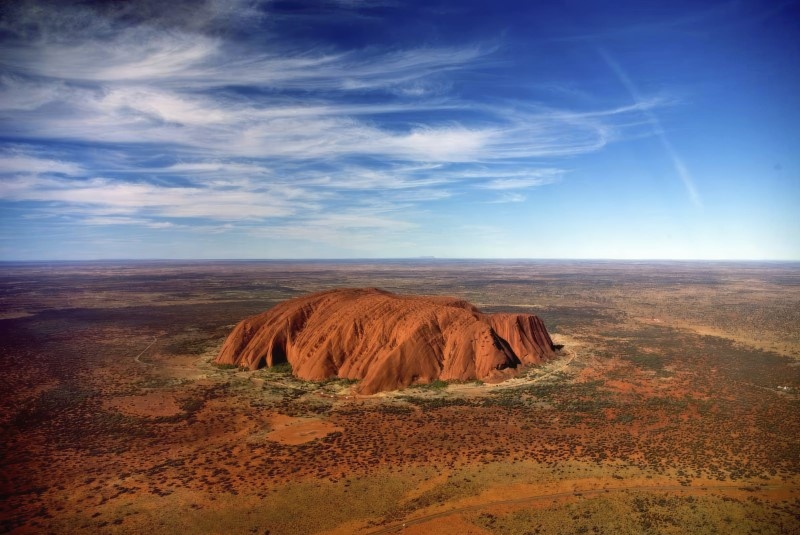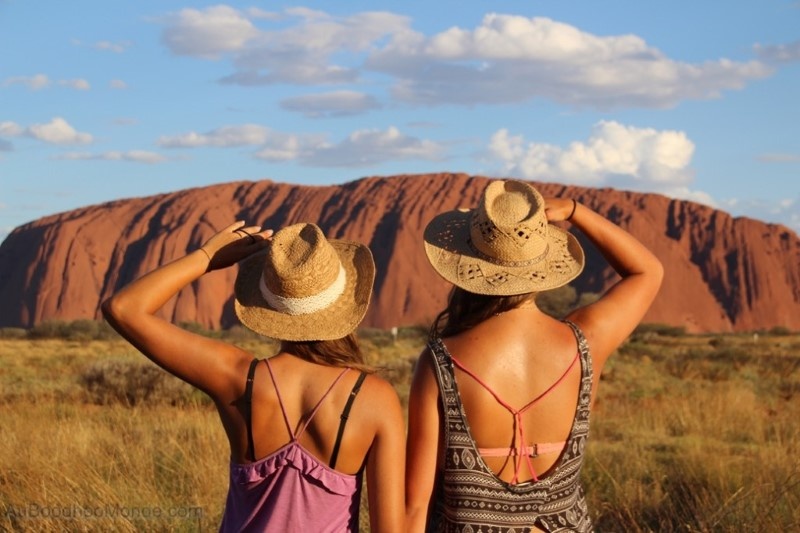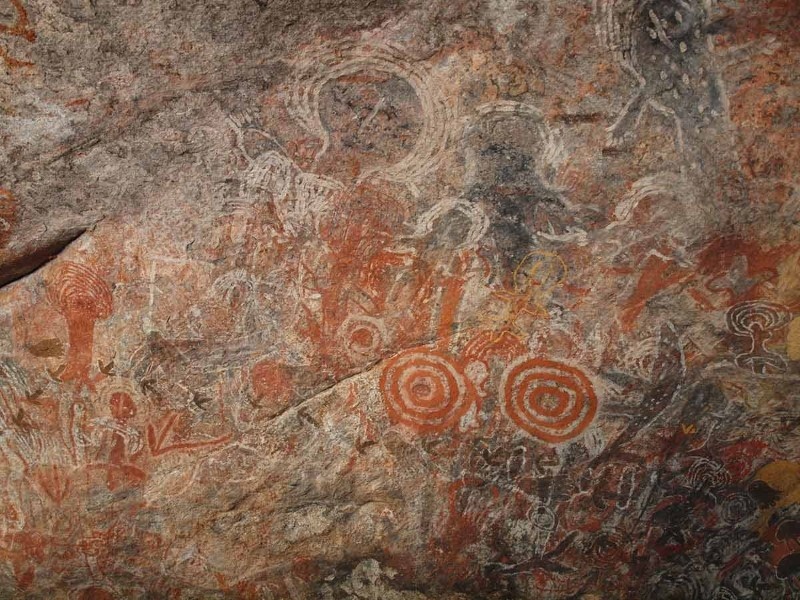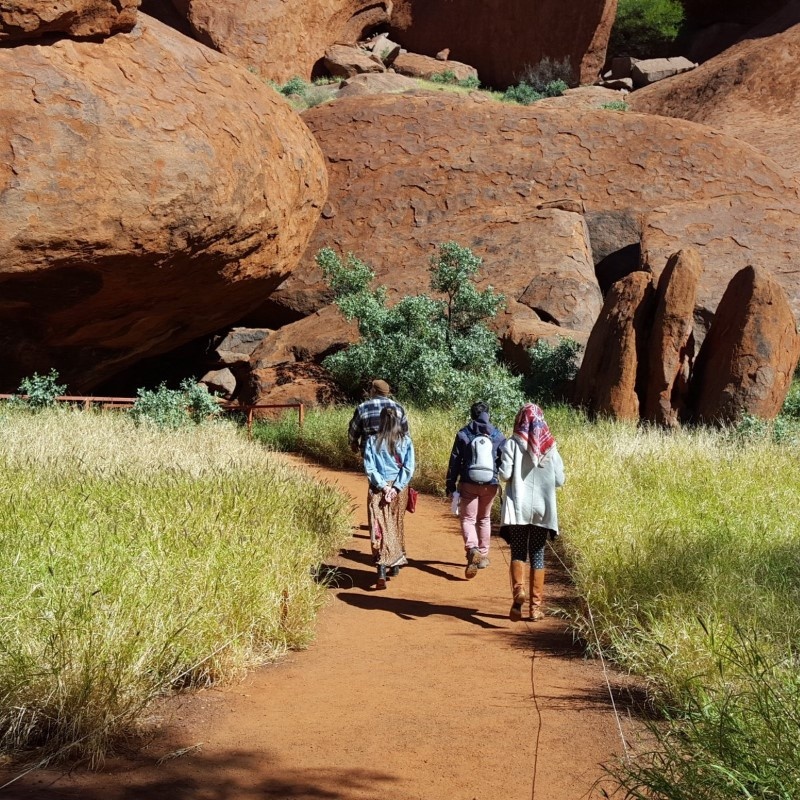
Uluru, also known as Ayers Rock, is a breathtaking sandstone monolith located in the heart of Australia's Red Centre and is one of the country's most iconic natural landmarks. Standing at a towering height of about 348 meters (1,142 feet) and measuring around 9.4 kilometers (5.8 miles) in circumference, Uluru is a majestic sight that draws visitors from around the globe. Its deep red hue, which spectacularly changes color at sunrise and sunset, creates a stunning visual display that captures the essence of the Australian Outback.
Situated within the Uluru-Kata Tjuta National Park in the Northern Territory, Uluru is not only a spectacular natural wonder but also a place of profound cultural and spiritual significance. It is deeply revered by the Anangu people, the traditional owners of the land, who have lived in the area for tens of thousands of years. The rock itself is imbued with Tjukurpa (Dreamtime) stories, making it a sacred site that offers a unique insight into Indigenous Australian culture.
Visitors to Uluru can engage in a wide range of activities designed to enhance their understanding and appreciation of this magnificent landmark and its cultural heritage. Guided walks around the base of Uluru provide an opportunity to learn about the Anangu culture, local flora and fauna, and the geological history of the area. While climbing Uluru is no longer permitted, respecting the Anangu's wishes, the experience of walking around its base offers a deeply enriching and respectful way to connect with the spiritual significance of the site.
In addition to exploring Uluru, tourists can visit the Uluru-Kata Tjuta Cultural Centre to gain further insights into the area's Indigenous culture through art exhibitions, performances, and workshops. Other popular activities include camel tours, scenic flights, and stargazing events, which offer unique perspectives on the stunning landscapes of the Red Centre.
Accommodation near Uluru caters to a range of preferences, from luxury hotels to camping under the stars, ensuring that visitors can find a place to stay that suits their style and budget. The nearby township of Yulara provides essential services and amenities, including dining, shopping, and tour bookings, making it a convenient base for exploring Uluru and the surrounding desert landscape.
Visiting Uluru is an unforgettable experience that offers not only the chance to witness one of Australia's most magnificent natural wonders but also to engage with the ancient cultures and traditions that make this region truly special. Whether you're drawn by the allure of the landscape, the rich cultural heritage, or the opportunity for adventure, Uluru promises an enriching and memorable journey into the heart of Australia's Red Centre.

The area around Uluru offers several walking tracks that allow visitors to explore the natural beauty and cultural significance of this iconic landmark. Here are the primary walking tracks around Uluru:
Uluru Base Walk
This is a 10.6 km loop walk that takes you around the entire base of Uluru. It is a relatively flat path and offers a comprehensive view of the rock, including close encounters with its flora, fauna, and several significant Aboriginal sites. This walk takes about 3 to 4 hours to complete.
Mala Walk to Kantju Gorge
This shorter walk is about 2 km return and takes approximately 1.5 hours to complete. It leads to Kantju Gorge, a quiet and deeply shaded area on the west side of Uluru. The Mala Walk includes an array of information boards that explain the cultural significance of the area to the Anangu people.
Kuniya Walk to Mutitjulu Waterhole
A relatively easy and short walk of about 1 km return that takes you to the Mutitjulu Waterhole, a key site of natural beauty and cultural importance. This walk offers insights into the local Aboriginal culture through rock art and stories.
Liru Walk
This 4 km one-way walk connects the Cultural Centre to the base of Uluru. It offers an opportunity to learn about the local flora, fauna, and the Aboriginal culture of the area.

The rock art at Uluru is a significant aspect of the area's cultural heritage, showcasing the rich traditions and spiritual beliefs of the Anangu people, the traditional owners of the land. This art is an essential part of one of the world's oldest continuous cultures, offering insights into the way the Anangu relate to the land, their ancestors, and their traditional practices.
Types of Rock Art
There are several types of rock art found at Uluru.
Petroglyphs: These are carvings or engravings made into the surface of the rock. They can depict various symbols, animals, and human figures, each carrying specific meanings within Anangu lore.
Pictographs: These are paintings on the rock surfaces, created using natural pigments. The colors are often derived from minerals and are predominantly red, yellow, white, and black. These paintings can illustrate stories from the Tjukurpa, the foundation of Anangu law and culture, including creation stories and teachings.
Significance
The rock art at Uluru is not merely decorative; it is deeply embedded in the Anangu's spiritual and cultural practices. The art serves as a record of ancestral beings' activities during the creation period, known as Tjukurpa. It guides the Anangu in law, culture, and connection to the land. The stories depicted in the rock art are passed down through generations, maintaining the continuity of knowledge and tradition.
Locations and Preservation
Some of the rock art sites at Uluru are accessible to visitors, often as part of guided tours that explain the cultural significance and stories behind the artworks. Sites like the Mutitjulu Waterhole are known for their rock art and are part of the accessible walks around Uluru.
Preservation of these sites is of utmost importance. Visitors are asked to respect the area by not touching the art or the rock surfaces, as oils from human skin can damage the delicate pigments and engravings. Photography restrictions may apply in certain areas to protect the cultural sensitivity of the artworks.
For those interested in learning more about the rock art and the cultural stories of Uluru, participating in tours led by Anangu guides or ranger-guided walks can offer valuable insights and a deeper appreciation of this remarkable aspect of Australia's cultural heritage.

Kulpi Mutitjulu is one of the most significant cultural sites at Uluru. "Kulpi" means cave, and Mutitjulu is the name of the waterhole located near this cave. It is situated on the eastern side of Uluru and plays a crucial role in the local Anangu culture and their traditional stories, known as Tjukurpa.
The cave is a key site for understanding the Aboriginal culture and history of the area. It contains ancient rock art that is of great spiritual significance to the Anangu people. The art and the site itself are associated with several ancestral beings and their stories, which are central to the Tjukurpa. These stories cover the laws of behavior, hunting practices, and the relationships between people, plants, animals, and the landscape. Generations of Anangu families told stories around the campfire here, teaching children and painting on the rock. These stories are still kept and handed down to Anangu children today.
Visiting Kulpi Mutitjulu
Visitors can indeed see Kulpi Mutitjulu when they visit Uluru. The cave is accessible via a short walk from the nearby parking area, leading to the Mutitjulu Waterhole. This area is part of a designated walking track that is well-signed and includes interpretative displays providing information about the site's cultural and natural significance.
The walk to Kulpi Mutitjulu and the Mutitjulu Waterhole is relatively easy and suitable for most visitors. It offers a unique opportunity to closely observe some of the traditional rock art and to appreciate the natural beauty of the waterhole, which is a vital water source in the desert landscape.
Tours led by Anangu guides or ranger-guided walks are available and are highly recommended. These tours provide deeper insights into the cultural stories associated with Kulpi Mutitjulu and other sites around Uluru. Engaging with these stories through the perspectives of the traditional owners enriches the visit and fosters a greater appreciation for the cultural landscape of Uluru.